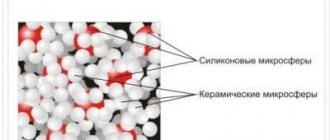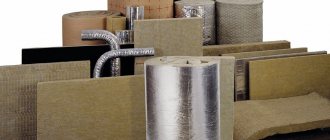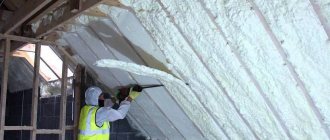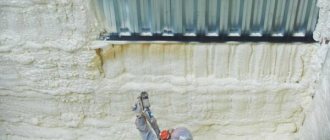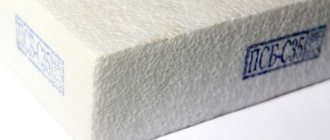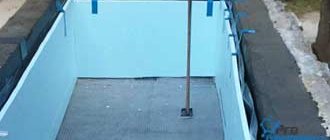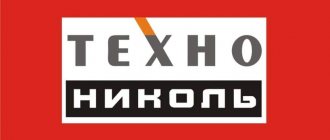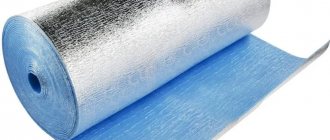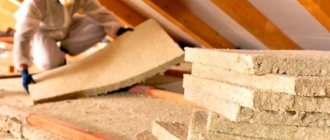The mid-90s of the last century was a turning point for the building materials market. Practical and inexpensive types of thermal insulation began to appear, for example, mineral wool, glass wool, and cellulose-based insulation. These materials attract the attention of buyers with their affordable price and relatively good characteristics.
However, there are also significant drawbacks. In particular, these are quite large materials, and the thickness of the insulation board “conceals” the interior space of the premises. In addition, such thermal insulation can dry out and become painted, which invariably leads to heat loss. Of course, mineral wool is still considered one of the popular thermal insulation materials today.
However, this is not due to high efficiency, but to an affordable price. If there is a need for really high-quality thermal insulation of premises, penoizol is used during construction. This is a liquid insulation material that is rapidly gaining popularity in our country.
What kind of insulation is this?
Simply put, it is foam plastic. In scientific terms - urea foam. Builders also call it jellied or liquid foam. It is obtained by mixing:
- urea synthetic resins;
- prepared water;
- foaming agent;
- orthophosphoric acid.
The components are loaded in a certain proportion into the foam generator. It mixes the components to a homogeneous jelly structure. Ready penoizol is poured into special niches for insulation.
Penoizol is a common noun. This is the name of the manufacturer in Russia. In fact, it is foamed polystyrene.
There is also the option of insulating with foam insulation in the form of slabs or crumbs. We will not focus on this method, since it is much inferior to the material in liquid form.
What is good about insulation with this heat insulator?
The material has a lot of advantages for which builders and installers value it:
- Excellent thermal conductivity . The insulation is able to withstand even severe temperature changes.
- The hardened heat insulator has high elasticity . It retains its shape after prolonged dynamic loads.
- Versatility . The material penetrates even into small crevices. It is capable of filling various voids and complex geometric shapes.
- There are no cold bridges . When installed correctly, it forms a monolithic layer of insulation. There are no joints or cold bridges.
- Air permeability . Penoizol is able to breathe. It can be mounted on wooden floors.
The insulation hardens in 10 minutes. Hardens in 4 hours. It takes its final form after three days.
Disadvantages of insulation
However, self-leveling foam also has its disadvantages, which should be taken into account before starting installation work:
- Self-leveling foam is afraid of the cold . You can start working at a temperature not lower than 5 °C.
- Low strength . Frozen penoizol can be bent to a certain state, but it breaks through easily. It can be pierced or torn.
- Dependency on equipment and power sources . You need special equipment and access to the power grid.
- The material absorbs moisture . It is not recommended for use in basements to insulate the foundation.
It is also important to maintain the correct proportion. The dried foam shrinks to 5%. It is important to accurately calculate the volume of penoizol before starting installation work.
Where is it used?
Photo:
Penoizol is widely used in private and professional construction. It is used not only as a heat-insulating material, but also as a sound-proofing component.
It is used for insulation:
- external walls;
- facades;
- roofs;
- pipelines;
- vegetable storage facilities.
The material is also intended for creating sandwich panels.
Granular penoizol has found application in insulating horizontal structures: floor surfaces, attics and interfloor ceilings.
Foil insulation can be used to insulate water pipes.
You should be aware that liquid foam has some restrictions on its use. For example, it is not recommended for use in areas exposed to intense moisture.
These include plinths, basements, foundations. The reason is simple: penoizol is able to withstand multiple cycles of freezing and thawing, but at the same time it loses its thermal insulation properties.
Experts also do not recommend using urea-formaldehyde foam for arranging roofing pie.
The fact is that the material quickly deteriorates under the influence of sunlight, which is why very soon after installation it can lose its heat and sound-proofing qualities.
Specifications
| Options | Minimum and maximum values |
| Thermal conductivity, (W/m) * C | 0,028 — 0,047 |
| Density, kg/m3 | 5 — 75 |
| Ultimate compressive strength (at 10% linear deformation), kg/cm2 | 0,07 — 0,5 |
| When bending, kg/cm2 | 0,10 — 0,25 |
| Tensile, kg/cm2 | 0,05 — 0,08 |
| Water absorption in 24 hours (by mass),% | 10,5 — 20,0 |
| Humidity (by mass), % | 5,0 — 20,0 |
| Operating temperature range, 0С | -50/+120 |
| Lifetime | 50 years |
conclusions
We must separately remember that many companies prefer a non-cash form of payment, which is why the money arrives in the account with some delay.
It is advisable to provide in advance not only for wholesale, but also for retail sales. This will ensure a regular flow of funds. This is a good start for aspiring entrepreneurs.
Even if he is far from construction, he is just looking for his niche. The business is easy to start with minimal investment and has an average payback period.
How much does foam insulation cost?
It is worth immediately noting the fact that insulation in this way is carried out by special teams. There is no point in buying a foam generator, it is too expensive. Renting equipment is also not very profitable. The operation must be done the first time. There will be no second chance. Therefore, you should immediately seek help from a specialized company.
The cost of used foam generators on Avito ranges from 50,000 to 150,000 rubles.
The average cost of insulation is 25,000 rubles per 10 m / cubic meter. One important nuance needs to be taken into account. Typically installation companies work on a volume basis. In this case, the seller will take the same price, even if the volume of insulation work is less than 10 m3/m3.
How to choose?
When selecting equipment, consider a number of nuances:
- To install liquid foam, two types of installations can be used: gas-liquid and pneumohydraulic technology. The first, budgetary one, is advisable to use for insulating small objects, for example, a private house. Pneumohydraulic equipment is characterized by large dimensions, productivity and cost. It should be chosen if large-scale work is necessary.
- It is recommended to give preference to installations with a built-in compressor and receiver.
- Pay attention to what the plunger pump is made of and its options. Choose a pump made of stainless steel or plastic. It must have a speed control function.
- You should not buy a unit with a foam generator attached to the pump part.
It is strongly not recommended to purchase penoizol “blindly”. Be sure to ask the seller to prepare the material and demonstrate its qualities.
The sample should:
- have a white color;
- do not decrease in volume immediately after leaving the installation sleeve;
- withstand hand pressure after 15 minutes of hardening;
- do not have large and heterogeneous pores;
- recover quickly after pressing.
If the prepared mass meets these requirements, you can safely purchase it.
Harmfulness of penoizol and impact on human health
Some people consider self-leveling foam to be a harmful substance. They indicate acids and resins in the material. In fact, at the time of pouring (insulation), penoizol releases a tiny amount of formaldehyde. It disappears literally within a few hours.
If installers work in protective clothing, they are not in danger. The hardened material does not emit any caustic or harmful substances into the atmosphere. This is evidenced by numerous certificates.
Use insulation only from trusted suppliers. Do not look for benefits in purchasing products without certification.
Flaws
The main disadvantages are different: penoizol is not suitable for all structures; it should act only as a middle layer and be reliably protected from external factors.
Penoizol gives significant shrinkage (1-3% of volume). Since penoizol can only be installed at a certain temperature, this may cause a delay in construction work, which is also a disadvantage.
Please note: penoizol can only be installed at an air temperature of 6 degrees or more.
Despite the fact that pouring insulation does not take much time, this work must only be performed by a specialist, otherwise the material may lose its properties.
Penoizol must be insulated. In addition, it is often necessary to additionally insulate the material in the structure, which leads to unnecessary costs.
If this has not been done, the insulation may release formaldehyde gas, which causes an allergic reaction in people.
It is the poor quality of work and material that causes negative reviews.
Be careful: before purchasing, you should make sure that the manufacturer is reliable and has quality certificates; beware of counterfeits.
This article is about the features of equipment for the production of penoizol.
Read the article about making penoizol with your own hands here.
Types of penoizol and use in thermal insulation
All heat insulators can be divided into two large groups:
- Jellied. Classic type of penoizol. It is used for insulating facades, walls, floors, ceilings, attics, and niches. The material is convenient in that it can flow into any voids without forming cold bridges.
- In the form of slabs. This is a frozen penoizol, which in its characteristics is very similar to polystyrene foam. You can install it yourself, without the help of specialists. This heat insulator is suitable for use on flat surfaces. For example, to insulate the facade of a building.
The main disadvantage of the second type of product is the presence of cold bridges, as well as the impossibility of covering complex shapes with a single layer of insulation.
Comparison of penoizol with other insulation materials
Let's look at the characteristics of insulation in the summary table. Let's compare its performance with the most famous types of thermal insulation:
| Material/Property | Coefficient of thermal conductivity | Temperature resistance | Environmental friendliness | Flammability class |
| Expanded polystyrene | 0.037 W/(m*K) | 90°C | Styrene releases when heated | G4 |
| Polyurethane foam | 0.028 W/(m*K) | 120 °C | Cyanide is released when burned | G4-G2 |
| Minvata | 0.032-0.039 W/(m*K) | Over 400 °C | Volatile fiber as an allergen | NG |
| Penoizol | 0.025-0.040 W/(m*K) | 270 °C | No discharge after drying | G1 |
It is also worth noting that rodents do not live in penoizol. They do not make moves and do not chew on frozen foam.
Price
One of the main advantages of the presented insulation is its price. Penoizol costs about 600 rubles/m³. At the same time, the quality of thermal insulation is not inferior to the popular insulation materials existing on the market today.
If we compare penoizol with mineral wool, a product with similar thermal conductivity will cost the consumer 1.5 times more. Moreover, the price of this insulation is 900-1000 rubles/m³.
The price of penoizol is 1.5 times lower than the cost of polystyrene foam. Material with similar thermal conductivity costs 950-1000 rubles/m³. The cost of extruded polystyrene foam is 6.6 times higher than that of penoplex. It is about 4 thousand rubles/m³ (taking into account the thermal conductivity coefficient).
Also, in terms of cost, urea foam is more profitable than basalt slabs, staple fiber and expanded clay. For this reason, many private property owners prefer this type of material.
Features of use
Features of using cast foam include:
- Temperature conditions. Some builders pour materials even in frosty weather. However, this method can affect the quality of the finished insulation.
- Availability of special equipment. The material can only be obtained in a special foam generator. This is a big overlay.
- The equipment requires constant power supply.
Please note that without electricity, work will not only stand still. The equipment itself will be at risk. As mentioned above, the material hardens very quickly. It will simply clog in the supply hoses and chambers. Therefore, it is important to keep backup sources of electricity generation in case of power outages.
It is also necessary to purchase special overalls, gloves and respirators for working with liquid foam insulation.
Manufacturers of urea foam plastic in the Russian Federation
Many companies in Russia and Europe are engaged in the production of penoizol. However, to purchase quality material, you need to take a responsible approach to choosing a manufacturer. Therefore, we advise you to pay attention to the products of such companies:
- "New construction technologies" . The company was founded in 1990 and specializes in the production of thermal and waterproofing, fiberglass, fiber-reinforced concrete. Today, this is one of the main suppliers of penoizol on the Russian market. By the way, the rights to use this trademark belong to this company.
- "Varmal LTD". This is a British company engaged in the production of liquid insulation flotofaum - the name of penoizol.
- LLC "Uveis" Russian company located in the city of Orenburg. The manufacturer has been working on the market for a long time, so it carefully monitors the quality of its products.
In addition, buyers speak positively about the products of ProTeplo LLC, Penoizol-Omsk LLC, and Murmansk Universal Plant CJSC .
Insulating a house with foam insulation
The material is used for both internal and external insulation of walls and ceilings. It is applied to the prepared surface. The use of penoizol allows you to create an additional layer of wall protection. It does not greatly reduce the interior space of the room. Let's consider all the stages of insulating the penoizol structure step by step.
Where to start finishing
Finishing work on insulation can be divided into two stages:
- Preparatory. The surface is cleaned from severe contamination, residues or concrete deposits. For three-layer or well masonry, holes are prepared into which insulation will be poured.
- A sheathing or frame is formed on the wall into which the poured foam will be supplied. It is best to make the sheathing from a bar or board.
Before purchasing a heat insulator, check its quality. Good penoizol has a snow-white color. He doesn't settle before our eyes. After 15 minutes the foam becomes elastic and durable. It wrinkles a little, but immediately returns to its original shape.
Necessary equipment
It all depends on what type of penoizol you will use for insulation. If it is flooded, you need to buy a special compressor for it. The finished sheets are installed using the same tools as conventional thermal insulation.
Standard set of tools:
- Hammer or drill. For making holes in the wall for filling.
- A utility knife to remove any remaining material.
- A screwdriver, if you need to build a frame for pouring.
Naturally, you need to buy protective clothing and a respirator.
Wall insulation
To insulate the walls of the house from the inside, you will need to build a sheathing or frame. The simplest way to make a structure.
- Install vertical guides from the block in increments of 50 cm.
- Make transverse inserts from the same block in increments of 50 cm. You should get square pockets.
- Stretch the special restrictive mesh so that the penoizol can cling to it. It will limit the distribution of material.
- Pour foam into the pockets.
Trim off excess insulation when it is completely dry.
Wood lathing must be treated with an antiseptic.
Interwall thermal insulation
In this case, penoizol is placed in the ventilation gap between several layers of the wall. Installation of insulation is carried out in two ways:
When building a house. Penoizol is poured as the parallel walls are raised. This method does not violate the integrity of the masonry.
In finished buildings. Holes are drilled in the outer thickness of the wall between the joints of the bricks. Penoizol is fed into the resulting holes floor by floor.
The material hardens within 3 days, after which all remnants of penoizol are cut off from the wall and the holes are sealed.
Roof and floor insulation
The insulation technology is similar to installing insulation on walls. It is performed by constructing an additional sheathing:
For the floor . Additional sheets of plywood or chipboard are laid between the joists. The wood is pre-treated with an antiseptic. You can also stretch a strong vapor barrier membrane. Secure the film between the joists using a furniture stapler. Fill the finished niches with foam insulation.
Exactly the same technology is used for the roof Penoizol is poured into special pockets, which are obtained as a result of film tension. Work is carried out on an open roof until it is covered with roofing material.
Thermal insulation of the facade with cladding slabs
When insulating a facade, the easiest way is to use double lathing. In this case, it is important to follow the following work algorithm:
- Install horizontal sheathing of wooden blocks in 50 cm increments along all walls.
- Cover it with durable vapor barrier film. Stretch the membrane using a furniture stapler.
- Install a vertical frame from the same block with a pitch of 50 cm directly on top of the vapor barrier.
- Make neat cracks in the vapor barrier and pour penoizol into the resulting pockets.
- Wait for the foam to dry. Remove excess material.
Install the sheathing over the second layer of sheathing.
Required Tools
The production of a solution requires gas-liquid installations that mix the components and deliver them to surfaces or into molds. You will also need containers for rheostats and an air compressor, which is based on stainless steel or plastic; the unit must have a speed-regulating function.
It is not advisable to attach the generator to the pump.
Large-scale construction requires pneumohydraulic dimensional equipment; private developers make do with a balloon system.
To reduce costs, it is not prohibited to independently assemble equipment consisting of gas liquids, hoses supplying foam, plastic vessels, taps and a compressor device. The equipment is assembled according to the instructions, followed by combining the ingredients.
The order of further steps:
- The old cladding is being dismantled.
- The sheathing is installed.
- Wooden logs are installed.
- The product is distributed evenly.
- Excess is cut off.
- Reinforcing mesh is installed.
- The final stage is facing operations.
When purchasing a mixture in a store, an employee prepares it, clearly demonstrating its properties. The sample must stand out with a white color, when leaving the sleeve, it must not change its volume to a lesser extent, must not contain large heterogeneous pores, and restore its format after mechanical impact. If these requirements are met, feel free to buy the product.
It should be remembered that the highest quality of installation can only be guaranteed by certified installation organizations.
Modern building materials are constantly being improved, providing convenience to consumers who have already appreciated the new thermal insulator, noting the reduction in energy consumption during cold periods.
Do-it-yourself penoizol at home - video
We do not recommend experimenting with the production of penoizol at home. It is very difficult to get the right consistency. In addition, you will have to work with aggressive environments: phosphoric acid and resins.
It’s easier to buy a ready-made mixture and rent equipment. However, this should only be done if you already have experience using a foam generator. Another important point is service. The equipment must be cleaned of penoizol residues so that it does not fail.
Consumption rates for insulating material per 1m2
When planning a construction budget, you need to accurately determine the amount of material. To determine the amount of liquid insulation that will be required to insulate the entire building, you need to know the consumption rates of penoizol per square meter.
According to manufacturers, the consumption of liquid foam per 1 m2 varies between 1-1.3 liters.
To calculate the required amount of material, you need to multiply the length and width of the wall by the consumption rates stated by the manufacturer. For example: 7*3.2*1.3=29.12 l. In this case, the final amount of thermal insulation must be taken with a small margin, taking into account unforeseen situations.
Penoizol over time
The finished material shrinks over time. It may decrease in volume by 3%. And sometimes penoizol shrinks almost in half. Some owners discover similar incidents after 5-10 years, when they carry out preventive maintenance on the walls. This happens because of the desire to save money. The installation crew or the owner himself uses cheap resins, which very quickly break down in the structure of the finished material.
You shouldn't skimp on insulation. Otherwise you will have to dismantle the entire wall. It is better to immediately buy high-quality penoizol or use the services of trusted companies.
Equipment assembly
The components can be purchased online at a more affordable price. Typically, this is done by contacting private sellers who post their messages. Some manufacturing companies also operate according to this implementation scheme. The process technology and drawings are described on thematic portals.
The most inexpensive devices contain the following devices:
- compressors;
- plastic barrels where solutions with catalyst are stored. Minimum volume of 300 liters;
- hose through which the mixture is supplied. Such equipment has only one drawback - unreliability. But it is easy to avoid;
- gas-liquid installation;
- set with taps.
The owners will probably have some parts in stock. But you shouldn’t skimp on the pump; it should be of the highest quality possible. Models that support the so-called double foaming are effective when producing penoizol; you can also make equipment yourself.
A compressor with a certain power is purchased. Such installations are also sold in construction markets and in special equipment stores. The pump should output about 4-5 atmospheres.
Plunger and vortex units will be the optimal choice in most situations. The main thing is to protect them from large particles getting inside, for which additional filters are purchased.
It is better to take a metal pump body, then the service life will be maximum. It is better to find a trusted seller who is not in doubt. Then the insulation of materials will then be of high quality.
